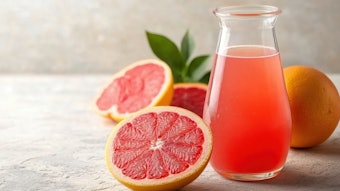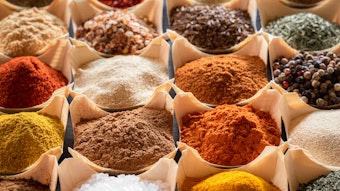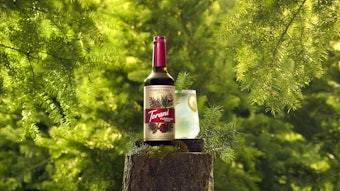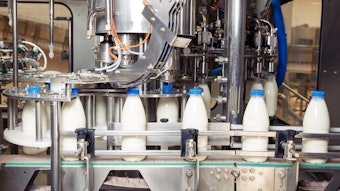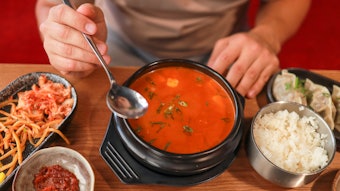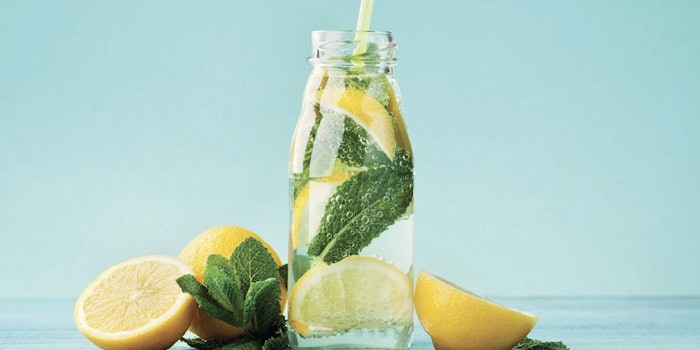
Nanoemulsions with very small particle size (r <100nm)—which are transparent when properly formulated—are being increasingly utilized in food systems, flavor delivery and the pharmaceutical industries to protect and deliver lipophilic functional components, such as flavor oils, colors, active ingredients, vitamins and pharmaceutical ingredients.
These unique nanoemulsions can be made at a very low surfactant-to-oil ratio with very simple processing required, such as high shear mixing, homogenization and in some cases, simple mixing. It is known that nanoemulsions perform better than conventional emulsion systems because of their small particle size, the absence of weighting agents, and their higher stability against gravitational separation. Due to the fact that the droplets do not aggregate, they maintain a transparent appearance when diluted and have been proven to enhance the bioavailability of lipophilic substances. As a result, flavor oils and oil soluble colors when formulated in a nanoemulsion can be incorporated into optically transparent beverages without losing their transparent character. Nanoemulsions containing vitamin E or oil-soluble drugs can be released in a gentle and sustained way as a result of the nanoemulsion’s interfacial film, which leads to improvement in drug bioavailability across the skin. This review provides an overview on the current statues of nanoemulsions, their preparation and ingredients used and their application as it applies to non-water soluble flavors, colors functional ingredients and drug delivery.
The potential to increase bioavailability has gained the interest of food and beverage formulators as a means to develop more healthy functional products, which are stable and optically clear.
Introduction
Conventional emulsification allows immiscible components, such as oil and water, to be compounded into a single macrophase mixture together with an emulsifying agent with the addition of mechanical work (homogenization). These systems are optically opaque, thermodynamically unstable and subject to physical-chemical changes over time. As a result, these changes pose a major concern to formulators because of the required shelf life of the product containing these systems. Conventional emulsions have long been used in the food industry and are a major component to many beverages in the marketplace today. When added to a liquid beverage system, they offer a suitable means to deliver oil-soluble materials in an aqueous base; while providing adequate stability, a degree of cloudiness and mouthfeel in certain applications when consumed.
Typical problems associated with conventional emulsions are as follows:
1.) Flocculation: the irreversible aggregation of the dispersed-phase droplets that eventually separate in a gravitational field (identified as creaming) with the droplets retaining their integrity, and
2.) Coalescence: an irreversible fusion of droplets that reduces the interfacial area and, therefore, increases the interfacial free energy of the system.
As a result, the emulsion separates into two discrete bulk phases. Therefore, the use of conventional emulsions have resulted in technical concern whenever these systems are applied to food, beverage, pharmaceutical, cosmetic products, or the delivery of oil soluble color ingredients when the dispersed phase is not miscible in water. To overcome these concerns, formulators have tried utilizing various gums, stabilizers and/or polymers (ionic or non-ionic) as a means to create greater stability, all with limited success.
Today, with consumer interest shifting to more healthy products and formulators looking for ways to increase the functionality of healthy ingredients not only in the product, but also in the body, conventional emulsions may not offer all the desired attributes needed. With the recent desire for clean labeling, the use of natural flavors and color ingredients, and the desire for healthy ingredients driving many consumer choices when product selections are being made, the need for new and unique delivery systems are required. To this point, liquid delivery systems that can offer greater stability, that can be easily formulated, that can deliver active ingredients more efficiently in the body, and that can remain transparent are highly desirable.
Since the 1940s when the term “microemulsion” was first introduced to describe transparent or translucent systems that formed spontaneously when oil and water are mixed with the right surfactant and co-surfactant (usually a medium chain length alcohol), these systems have been of great interest to the food, beverage and cosmetics industries. Their inherent drawback has always been the fact that many of the surfactants and co-surfactants required are not approved for food use. It is worth mentioning that microemulsions consist of very small droplets with a radius of 50 - 500Å of either oil-in-water (O/W) or water-in-oil (W/O). Unlike conventional emulsions (macroemulsions), microemulsions differ in two aspects, namely in their thermodynamic stability and their lack of turbidity. The most significant difference between an emulsion and a microemulsion lies in the fact that putting more mechanical work into an emulsion (i.e. high sheer mixing) or increasing the surfactant concentration usually improves their stability. This is not the case with microemulsions, which are dependent on their formation on specific interactions at the oil/water interface between the oil, surfactant and the co-surfactant. If these interactions occur, spontaneous microemulsification occurs with no mechanical work required.
Recently, in the area of food and beverage development, nanoemulsions have gained increasing interest because they offer many of the positive attributes of microemulsions and can be formulated with food-approved ingredients to deliver flavor oils, oil soluble colors and vitamins. The many benefits of nanoemulsions include infinite diluatability, small particle size, ease of preparation and enhanced bioavailability. In addition, nanoemulsions can be produced at a lower surfactant-to-oil ratio, a factor highly desirable to manufacturers because of lower ingredient cost and clean taste when compared to conventional emulsion systems. In some product applications, a high dosage of emulsifier will result in an unacceptable bitter taste and/or astringency, which must be overcome with the addition of flavors and/or other ingredients. In addition, the use of nanoemulsions has also expanded to the pharmaceutical segment for oil-soluble drugs and active ingredient delivery. In this case, nanoemulsions can be fabricated to make many oil-soluble drugs and actives display high water solubility with improved bioavailability of the drug, as well as reducing some of the drug’s toxic side effects. The potential to increase bioavailability has gained the interest of food and beverage formulators as a means to develop more healthy functional products, which are stable and optically clear.
Nanoemulsion Formation
Nanoemulsions can be produced using a variety of approaches, namely, high-energy or low-energy methods. For the high-energy method, mechanical devices, such as a high shear mixer, homogenizer, microfluidizer or an ultrasonicator can provide the energy required to break large droplets into very small droplets1. Low-energy methods or the spontaneous method, include spontaneous emulsification, phase inversion temperature (PIT) and emulsion inversion point, which rely on the physical aspects of the ingredients used and the conditions of the environments, such as temperature, pH and ionic strength.
The high-energy method is most commonly used in the cosmetic, food and pharmaceutical industries due to the fact that the equipment is readily available and the method has a long history of successful use. Small particles can be achieved by the input of high energy, and the droplet size is determined by the type of homogenizer used, the operating conditions (energy strength, duration and temperature), and the ingredients used to formulate the product (the oil type, surfactant, concentration, etc.), as well as other physical-chemical properties (i.e., the interfacial structure, interfacial tension and viscosity). As higher pressures produce smaller particles which result in a larger surface area, the formula may require additional emulsifier to fully cover the increased interface while providing increased stability and reduce droplet aggregation (coalescence and flocculation). In many cases, more than one cycle of homogenization is needed to disrupt the large dispersed phase droplets in solution to overcome the restorative forces that hold the droplets in spherical shape; and simultaneously producing smaller droplets within a narrow particle size distribution.
Nanoemulsions offer a perfect solution for the encapsulation and delivery of pure lemon, orange and other oils which allow for improved solubility, enhanced stability, fresh taste perception and smell.
When we consider nanoemulsion formation, the surfactant plays an important role. The addition of emulsifier into the immiscible oil and water phases will reduce the interfacial tension greatly leading to the formation of an O/W or W/O nanoemulsion depending on the surfactant used. The surfactant can be categorized as large molecular weight emulsifiers (sodium casineate, arabic gum, modified starch, etc.) or a small molecular weight emulsifier (sucrose ester, monoglyceride, polyglycerol ester, etc.). The small molecular weight emulsifiers can be further classified as non-ionic, ionic (anionic, cationic) and zwitterionic surfactants. Sucrose ester and monoglycerides are two of the most common non-ionic emulsifiers used in the food industry and have been used for many years successfully. During nanoemulsion formation, small molecular weight emulsifiers can adsorb quickly to the newly formed droplet interface and in the case of O/W nanoemulsions, the hydrophilic tail will protrude into the water phase, resulting in an increase in the solubility of oil phase. Electrostatic repulsion and steric repulsion are the two main forces that can help guarantee emulsion and nanoemulsion stability. The combination of non-ionic and ionic emulsifiers will help further reduce the interfacial tension and form a more structured interfacial film. This may also generate a more stable nanoemulsion with small droplet particle size as the result.
For a given system, there is a critical Weber number (Wecr). If an emulsion has a Weber number above the critical value, the droplets will disrupt and break. If this is not the case, the droplets will remain intact (see F-1). The critical value for a nanoemulsion in the absence of the emulsifier depends principally on the ratio of the viscosities of the dispersed (hD ) and continuous phases (hC). The Wecr has a minimum value when hD/ hC is between 0.1 and 1.02, which increases the droplets’ disruption during shearing or homogenization. Droplets are resistant to disruption at low viscosity ratios because they are able to elongate before disruption occurs. Droplets are resistant to breakup at high viscosity ratios (>5) because they do not have sufficient time to become deformed before the flow field causes them to rotate to a new orientation and therefore alter the distribution of disruptive stresses acting on them. Therefore, for some applications when high viscosity oils are used, low viscosity oil compounds should mix with them to adjust the final viscosity. Some co-solvents, such as glycerol, propylene glycol and sorbitol, can be used and added to the water phase to adjust the viscosity ratio as well.
HLB (Hydrophilic Lipophilic Balance) is also an important parameter in the formulation of nanoemulsions. HLB is a measure of an emulsifier’s affinity to water or oil. Higher value suggests high affinity to water, while low values imply an affinity to oil. Oils and lipids have their own HLB value as shown in T-1. We know that the closer the HLB value is between the oil phase and emulsifier used, the easier the nanoemulsion will form. Adjusting the ratio of emulsifier with high HLB and low HLB to approach the target HLB value of oil phase is a critical method to form nanoemulsions with good stability.
Applications of Nanoemulsions
Nanoemulsions, originally known as submicron emulsions during the 1950s, were mainly used for delivering oil-soluble ingredients in aqueous systems in the food, cosmetic and pharmaceutical industries. In this section, a concise overview of potential applications of nanoemulsions is given. We will demonstrate that the emulsifiers utilized in nanoemulsion formation play a key role and provide a short overview on the mechanism of formation.
Nanoemulsions for Flavor Delivery
For the past few decades, with the development of nanotechnology, liquid nanoemulsions have been of great interest to many industries. The ability to deliver oils and oil soluble ingredients in water that is optically transparent has gained interest, specifically in the beverage industry where oil-soluble flavors and ingredients can be added to clear beverage without affecting their turbidity. This technology is gaining global interest and more and more food and beverage companies appear to be interested in using this technology. These systems endow the beverage with authentic smell and taste, as well as the ability to provide excellent stability and bioavailability of active ingredients.
Lemon and orange oils are two of the most commonly used ingredients in the beverage segment with high consumer appeal. It is well known that pure citrus oils have all the functional ingredients capable to deliver and contribute to the real, fresh taste and smell profile of the fruit when formulated and delivered properly in a beverage base. However, use of these ingredients if not properly formulated can cause various problems, i.e., creaming, ringing and full phase separation, all derived from the instability phenomenon brought about when these ingredients are used without suitable emulsifiers or emulsification techniques. Improving the water solubility of orange and lemon oils can be achieved by reducing the water insoluble compounds present in the pure oil, but this often results in a reduction of fresh taste and smell. Nanoemulsions offer a perfect solution for the encapsulation and delivery of pure lemon, orange and other oils, which allow for improved solubility, enhanced stability, fresh taste perception and smell.
Lemon and orange oils are natural complex substances isolated from the peel of the citrus fruit and are widely used in the food, beverage and flavor industries. Folding these oils results in improved water solubility which is achieved by distilling the single fold lemon oil (1×) and removing some of the more water-insoluble ingredients, in this case terpenes (limonene, pinenes, etc.). Threefold (3×), fivefold (5×) and tenfold (10×) oils are commonly used and can easily be achieved through distillation. Oils from different growing regions may differ in their component composition and levels of specific ingredients present, hence, their physicochemical properties, such as water solubility, density, viscosity, refractive index and optical properties3 may differ. As a result, the oil density and viscosity increases as the oil fold increases. Formulators, flavorists and product developers are always looking for ways to achieve better oil solubility without negatively impacting their taste profile. In this case, nanoemulsions offer one of the best vehicles to achieve improved delivery and use.
Thus, in order to fabricate transparent flavor microemulsions or nanoemulsions, there are a few significant factors to consider. For microemulsions, finding the right combination of oil, surfactant and co-surfactant that are food grade is critically important. In addition, for O/W microemulsion formation, simple geometric calculations can assist in identifying the right amount of surfactant required for a given amount of dispersed oil phase. In most cases, the amount of surfactant required is relatively low compared to the volume of oil used. In addition, ethanol, glycerol and propylene glycol can be used in small amounts as a co-surfactant. The role of the co-surfactant is to decrease the Gibbs free energy δGto a value below zero, generating a spontaneously forming, thermodynamically stable dispersion with a very small droplet size.
In the case for forming nanoemulsions, critical factors include, first, trying to match the refractive index difference between the disperse and continuous phases, and second, choosing an emulsifier that allows the smallest oil droplet size to be formed in solution (see T-2). However, in the case of forming nanoemulsion, the dosage of these ingredients is usually much higher than required to form microemulsions and may reach levels of 50~60 wt% at maximum.
Choosing the correct surfactant or surfactant combination is a key step for fabricating stable flavor nanoemulsions. Normally, oil-in-water (O/W) nanoemulsions are more widely used than the reverse water-in-oil (W/O) systems. Therefore, surfactants with high HLB (10-20) should be chosen as the main emulsifier, i.e., polyoxyethylene sorbitan fatty acid esters, sucrose esters and polyglycerol fatty acid esters to mention just a few. Ingredients such as gum acacia or modified starch offer little benefit, as they show limited ability to absorb at the O/W interface and help reduce the particle size to values smaller than 100nm, which by definition is in the range of a nanoemulsion. Thus, large molecular weight surfactants will only occasionally be considered as emulsifiers for nanoemulsions.
Jiajia Rao and David Julian McClements studied the formation of lemon oil nanoemulsions using polyoxyethylene sorbitan monooleate (Tween 80)4. Tween 80 is a nonionic surfactant with HLB 15. The structure of Tween 80 is shown in F-2. The concentration of Tween 80 used and the homogenization method applied are two important factors to consider in forming nanoemulsions. In this case, the continuous phase consisted of propylene glycol and water at mass ratio 1:2. With low energy input (heat treatment), a high surfactant-to-oil ratio (SOR) was suggested, in the range of 1-2, respectively. For a 10% lemon oil system, the turbidity of the colloidal dispersion remained low and constant after thermal treatment (90°C for 30min) when the concentration of Tween 80 was between 13% and 19%. At lower Tween 80 concentrations, separation of the system was observed. A cream layer on top of the milky layer was observed which indicates that large particles forming in solution are able to strongly scatter light. As a result, increasing the Tween 80 concentration resulted in the turbidity decreasing and the formation of smaller particle size in solution. That is to say, for the system with low energy input, a high concentration of Tween 80 is needed to produce stable nanoemulsions.
Another nonionic surfactant, sucrose monopalmitate (SMP), can also be used as an effective emulsifier to form nanoemulsions. SMP is a non-toxic, biodegradable and food-approved surfactant, which is colorless, tasteless and odorless making it more acceptable than other emulsifiers. The structure of SMP is shown in F-3. Lemon oil nanoemulsions prepared with low surfactant to oil ratios (SOR£1) provided interesting results. For systems with 10 wt% lemon oil, the diameter of the droplets decreased from 280nm to 120nm containing 1% SMP, from 320nm to 85nm for 5% SMP, and from 440nm to 15nm for 10% SMP after homogenization (three passes at 9,000 psi). For 1% SMP and 5% SMP, the system can be considered a nanoemulsion as the mean radius was less than 100nm. For the 10% SMP, the small droplets in the range of 15nm is in the size range of a microemulsion, but the system is not thermodynamically stable. These results suggest that nanoemulsions can be generated at low surfactant to oil ratios with the help of homogenization at high pressure. The low emulsifier dosage required can provide food and beverage companies cost savings while minimizing negative flavor taste effects in the final product due to the added emulsifier.
Modified Starch (MS) and Quillaia Saponins (QS) are two emulsifiers that have been used to fabricate nanoemulsions. Jian Zhang and Lu Bing compared the functionality of forming and stabilizing orange oil nanoemulsions using these two ingredients5. Ester gum was incorporated into the oil phase to inhibit the occurrence of Ostwald ripening and for viscosity adjustment. The addition of ester gum also increased the density of the lipid phase and reduced the density difference between the oil and water phases, which resulted in better stability of the system. Normally, the density of orange oil is 0.844g/ml at ambient, while the density of ester gum is between 1.06-1.09g/ml. The smaller the density difference between the dispersed and continuous phases, the better the stability and the less tendency for creaming to occur. Meanwhile, the addition of ester gum to the oil phase also helped to adjust the hD/ hC to a suitable value, resulting in maximum break up of oil droplets during processing. These results show that QS orange oil nanoemulsions with small particle size have better stability during storage, while the particle size of nanoemulsions fabricated by MS increased appreciably after formation and demonstrated less stability. As we know, QS is a small molecular weight surfactant whereas, MS is a large molecular weight surfactant. Small molecules like QS are able to better absorb to the oil droplet interface during shearing or homogenization and coat the oil droplets with a hydrophilic layer which can inhibit the merging of oil droplets in solution. In addition, the zeta potential values of nanoemulsions stabilized with QS gained an interfacial charge, ranging from -23 to -33mV, while MS stabilized nanoemulsions showed a low interfacial charge of about -5mV. Higher charge provides stronger electrostatic repulsion, which is one of the mechanisms of stabilizing nanoemulsions. Therefore, the particle size of orange oil nanoemulsions stabilized by QS remained small and very stable during storage.
Energy input is an indispensable factor for the fabrication of emulsions for food, cosmetic and pharmaceutical applications. It is well known that increasing the energy input can reduce the amount of emulsifier needed for the formation of emulsion systems and the same is true for nanoemulsions. For nanoemulsions, simple mixing, thermal treatment and homogenization are three of the most common methods of providing energy. At ambient temperature, there is a kinetic energy barrier in the oil-water-surfactant system that prevents it from transitioning from a simple miscible system to a homogeneous, transparent nanoemulsion. Added heat and homogenization provides the required energy to facilitate this transition to occur. The added energy overcomes the system’s internal kinetic energy barrier and promotes the transition from one state to another forming an optically transparent, stable nanoemulsion.
Nanoemulsions for Color Ingredient Delivery
Lutein,β-carotene, paprika and curcumin are widely used water-insoluble color ingredients in beverage to provide color and an attractive appearance. The solubility of these ingredients currently limits their full application potential. Methodologies to increase the solubility of oil soluble ingredients in aqueous media have become a key area of interest to researchers studying nanoemulsions. The increased interest in color delivery using nanoemulsions can be seen if one looks at the number of publications over the past ten years. The chart in F-4 demonstrates the increased level of interest, which has significantly grown, especially from 2015. This demonstrates that nanoemulsions have become an effective method for improving the water solubility of hydrophobic color ingredients to broaden their utilization.
Yuan, Yuan and Yanxiang Gao studied the influence of emulsifying conditions, emulsifier type and concentration, homogenization pressure, temperature and cycle on the properties and stability of β-carotene nanoemulsions6. β-Carotene, normally in the form of a powder or oil suspension, dissolved in medium chain triglyceride (MCT). Heating to 140°C should be considered a necessary process if one is to use this material in the formation of nanoemulsions. The addition of MCT not only acts as a solvent for β-carotene but can also aid in adjusting the viscosity of oil phase to a suitable value. Polyoxyethylene sorbitan monolaurate (Tween 20), polyoxyethylene sorbitan monomyristate (Tween 40), polyoxyethylene sorbitan monostearate (Tween 60) and polyoxyethylene sorbitan monooleate (Tween 80) at various concentrations were used as the primary emulsifier to compare the performance of forming β-carotene nanoemulsions. The mean diameter ranged from 132nm to 184nm with a unimodal distribution for all the emulsifiers used. The nanoemulsion prepared with Tween 20 achieved the smallest particle size at all concentrations studied. The results suggest that Tween can be used to produce β-carotene nanoemulsions effectively. Tween 20 has the highest HLB value among all the emulsifiers used, indicating that the greater hydrophilicity the more stable the resulting nanoemulsion will be. As shown by Tan and Nakajima, emulsifiers with greater hydrophilicity adsorb at the oil droplets’ interface quickly and stabilize the particles in O/W nanoemulsions more efficiently, thus bringing about the smallest particle size7. According to Stoke‘s Law, forming small particles is a vital parameter to ensure the stability of a dispersed system.
Homogenization is one of the most commonly used processes in forming nanoemulsions. The parameters of homongenization, such as temperature, pressure and cycles, should be chosen with caution to achieve nanoemulsions with the highest stability. The particle size decreases gradually as the temperature increases from 30°C to 50°C, while further increasing the temperature does not cause an additional reduction of particle size. At 70°C , the particle size increased aggressively. This result can be explained if one considers the Cloud Point of the non-ionic emulsifier used. The Cloud Point is defined as the temperature above which an aqueous solution of water and water soluble surfactant becomes turbid. Tween 20 has a cloud point of about 76°C and as a result, hydrogen bonding between the emulsifier and the aqueous phase becomes weak as the cloud point temperature is approached, resulting in a decrease of the solubility of the emulsifier and a negative effect on the ability of the emulsifier to coat the oil droplet interface. Therefore, it is important to mention that the homogenization temperature should be lower than the Cloud Point when non-ionic emulsifiers are being used.
Meanwhile, it’s important to consider that appropriate homogenization pressure should be taken into consideration, as higher pressures will lead to higher shear force and higher turbulence and smaller droplet sizes will be achieved. However, smaller diameter means more surface area was exposed and more emulsifiers will be needed to fully cover the droplet surface. The cost of forming β-carotene nanoemulsions increases as a result of higher homogenization pressure because of the higher energy requirement. Normally, the first stage and second stage of homogenization are around 250Mpa and 50Mpa respectively.
Lutein is another interesting ingredient to provide attractive color for foods and beverages, but color is not the only function of lutein. Lutein is an effective medication for macular degeneration. However, the utilization of lutein is restricted by its poor water solubility. Chaemin Lim and Da-won Kim researched generating lutein-loaded nanoemulsions for ophthalmic eye drops. When you consider eye drops for normal ocular drug delivery, the functionality and bioavailability of the drug may be restricted by low corneal permeation of the eye and rapid drug removal from the absorption site by eye blinking8.
Nanoemulsion drug delivery has been reported as a powerful way to delivery lutein with high bioavailability. In the research, isopropyl myristate (IMP) and Tween 80 were chosen as the oil phase and surfactant respectively due to their high solubilizing ability for lutein. Ethyl alcohol (EtOH) was selected as co-solvent to further decrease the interfacial tension, producing smaller droplets and better nanoemulsion stability. In this case, IPM and EtOH were mixed as the oil phase and Tween 80 and triacetin were mixed at a fixed ratio as surfactant. A phosphate buffer in saline (PBS) was used as the water phase. A pseudo-ternary phase diagram approach was used as the self-emulsifying method to determine the formation of nanoemulsions from their optical appearance and particle size.
The results achieved demonstrated that lutein nanoemulsions delivered a higher degree of lutein functionality to the eye, in addition to a higher rate of delivery when compared to a lutein system composed of lutein dissolved in soybean oil and starch. For lutein nanoemulsions, more than 40% of the lutein was released within 24 h, followed by a gradual release over 144h, while less than 5% of lutein was released from soybean oil and starch based system. Lutein-loaded nanoemulsions have excellent wetting ability and corneal permeation. All the components used demonstrated low irritation and toxicity as well as the advantages of easy eye surface reparation. Thus, nanoemulsions provide an excellent delivery system for delivery of lipophilic drugs for ophthalmic disease as well as other functional ingredients where bioavailability is of interest.
Curcumin delivery systems, as well as beverages, containing curcumin are becoming popular as consumer knowledge increases about healthy natural ingredients in specific foods that can benefit their overall health.
Nanoemulsion Application in Drug Delivery
Nanoemulsions perform quite effectively as delivery systems to transport water-insoluble functional ingredients through intravenous, ocular and dermal applications throughout the body, as well as to maximize their bioavailability.
For the delivery of lipophilic drugs, the oil-soluble drug should be dissolved in the oil phase, such as soybean oil or medium chain triglycerides, before blending with the water phase. Nevertheless, it is also possible to incorporate them after formation of the nanoemulsion. The physical location of lipophilic drug ingredient within the colloidal system depends on their molecular and physicochemical properties, such as hydrophobicity, surface activity, solubility, melting point, etc. Highly non-polar lipophilic components tend to be distributed in the hydrophobic core of the formed particles, whereas more polar lipophilic components may be incorporated within the amphiphilic shell.
Curcumin has been investigated over the past few decades because of its biological activity. Curcumin delivery systems, as well as beverages containing curcumin, are becoming popular as consumer knowledge increases about healthy natural ingredients in specific foods that can benefit their overall health. The poor water solubility (11ng/ml) limits the application of curcumin in water-based systems and thus negatively affects bio-accessibility. Kashif Ahmed and Yan Li studied the encapsulation and release properties of nanoemulsion-based delivery systems of curcumin9. Long, medium and short chain triacylglycerols (LCT, MCT and SCT, respectively) were chosen as the oil medium for curcumin to compare their performance for bioaccessibility. Curcumin is normally in powder form, dissolution in odorless and colorless oil should be done before nanoemulsion formation. Corn oil, Miglyol® 812 and tributyrin were used as LCT, MCT and SCT respectively. A microfluidizer was used to homogenize the coarse emulsion due to the fact that color nanoemulsion required higher pressure to break oil droplet into smaller ones. The final curcumin nanoemulsions contained 10 wt.% lipid phase and 0.15 wt.% curcumin.
Particle size results demonstrated that smaller particle size nanoemulsions with narrow particle size distribution (PDI) can be formed when LCT or MCT were used as the oil phase. However, nanoemulsions with relatively larger particle size were observed when SCT was used as the lipid phase. After 24h storage, the LCT and MCT nanoemulsions remain stable with homogenous appearance, while SCT nanoemulsion separated. The unstable SCT nanoemulsion may have resulted from the high water solubility of SCT when compared with LCT and MCT. It is known that the shorter the triglycerides chain, the higher the water solubility. Higher water solubility is one of the reasons causing Ostwald ripening, which is one possible destabilizing phenomenon. The Ostwald ripening can be inhibited by mixing the high water soluble oil with a low water soluble oil, such as LCT and MCT. The rate and extent of digestion of nanoemulsion containing different lipid phases were monitored by measuring the amount of free fatty acid released over time. There was a rapid growth of free fatty acid during the first 2,000s and followed by a gradual growth at longer time for all the three nanoemulsions as shown in F-5.
The final amount of free fatty acid of LCT nanoemulsions was much lower than that of SCT and MCT nanoemulsions. This may be due to the reason that long-chain fatty acid have a tendency to accumulate at droplet surface while SCT and MCT can be easily dispersed into the aqueous phase instead of being located at the surface. In addition, MCT nanoemulsions have a much smaller particle size than SCT nanoemulsions, and the larger surface area exposed to the lipase would account for the higher digestion than SCT nanoemulsions.
Nanoemulsions have been reported to increase the bioavailability of lipophilic nutraceutical ingredients and small particle size plays a great role in this function. Cho and Salvia-Trujillo studied the influence of particle size of nanoemulsions on the digestion rate and bioavailability of encapsulated lipid nutraceuticals10. The researchers designed emulsions with three different particles sizes (d32=0.21,0.70, and 2.27μm) by using Tween 80 as the emulsifier. The simulated Small Intestine Model (vitro studies) was used to evaluate the digestion and release mechanism of nanoemulsions. The results from F-6 show that there was an appreciable increase of free fatty acid for the three nanoemulsions at different particle sizes at initial incubation time followed by a gradual increase at longer digestion time. However, the nanoemulsion with the smallest particle size got the highest value due to the largest surface area exposed to the intestinal liquid.
Conclusions
Conventional emulsions are the most widely used delivery systems in the beverage industry for flavor delivery in products such as dairy drinks, protein drinks and milk tea. These drinks contain droplets that are relatively large in diameter, more than 200nm that can scatter light strongly and provide products with an opaque appearance. However, tea drinks, sport drinks, carbonate drinks and flavored water products are beverages that require clarity, low turbidity and low viscosity. Nanoemulsions provide a best choice for delivering lipophilic flavor oils, oil soluble ingredients or non-water soluble colors without affecting optical clarity. This is achieved due to the small particle size of the droplets in solution, since they do not scatter light to a high degree. Thus, flavor oil nanoemulsions and color nanoemulsions have recently received great interest in many food and beverage applications. The large interfacial area and composition of the droplet interface assists in helping to increase the bioavailability of oil ingredients including oil-soluble drugs, making these systems very useful to the pharmaceutical industry. In short, the characteristics of nanoemulsions make excellent delivery systems for water-insoluble ingredients.


